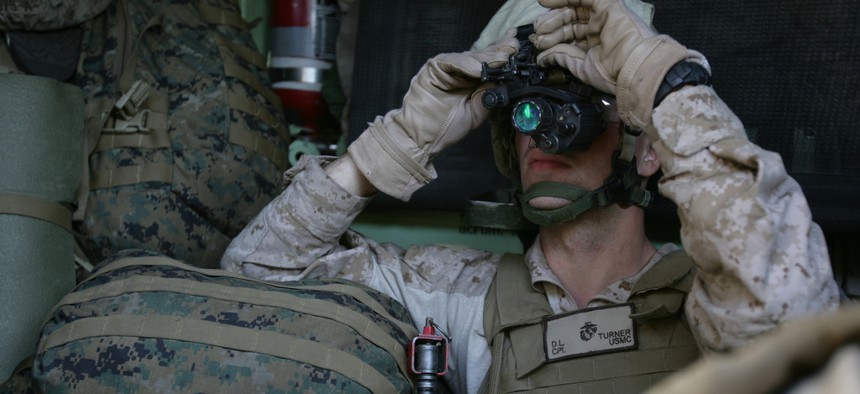
Cpl. Dustin Turner, a rifleman with the 1st Platoon, Company G, adjusts his night vision optics while riding in an Amphibious Assault Vehicle. U.S. Marine Corps
Here's the 'Game-Changing' Tech Special Operators Want for Tomorrow's Wars
Directed-energy systems, night vision googles with full color displays and suits you might find in a comic book origin story. By Bob Brewin
The Special Operations Command requires “revolutionary game-changing” technologies to support its mission, including portable lasers, color night vision systems and advanced battlefield wound dressings, SOCOM chief Adm. William H. McRaven said in written responses to questions submitted by the House Armed Services Committee after hearings this spring.
The written testimony – contained in two volumes highlighted by Steven Aftergood, director of the Federation of American Scientists’ Project on Government Secrecy – shows a prototype man-portable laser tested this winter powerful enough to disable electrical systems and electronic devices.
The prototype laser, developed by Boeing Directed Energy Systems and tested at Kirtland Air Force Base, New Mexico, weighed 750 lbs. -- too heavy to fit the man-portable description, and now SOCOM wants to develop a smaller and lighter version.
McRaven said SOCOM “is currently pursuing directed energy systems as a non-kinetic, stand-off anti-materiel solution.”
He added, "We have a requirement to surgically disable or disrupt a variety of fixed facility infrastructure and systems, with required capabilities ranging from breaching and access to disablement of critical equipment."
Why Is Special Operations Interested in Science of Shark Bites?
SOCOM also needs color night vision gear to maintain Special Operations Forces' tactical advantage at night, McRaven said.
“The goal of our color night vision effort is to provide the SOF operator the ability to see true color on a moonless night with just starlight – a tremendous tactical advantage,” McRaven said in his written response to the committee.
Uncontrolled hemorrhage remains the leading cause of death on the battlefield, McRaven said, which has led SOCOM to help back development of a “shark bite trauma kit,” which injects tiny sponges into a wound to stop the bleeding, and is awaiting approval from the Food and Drug Administration.
Dr. Anthony Pusateri, portfolio manager for the Defense Department’s Hemorrhage and Resuscitation Research and Development Program, recently said the shark bite kit, manufactured by RevMed X of Wilsonville, Oregon, is “primarily intended for deep wounds with heavy bleeding inside, with no way of putting direct pressure on the wound, and no way to wrap a tourniquet around it.”
SOCOM also continues to back development of the Tactical Assault Light Operator Suit – the so-called Iron Man suit, named after the fictional Marvel Comics superhero – to protect its troops, a project that kicked off last September.
“The development of powered exoskeletons, advanced armor and lightweight power generation and distribution systems have wide-ranging potential uses,” McRaven said. “TALOS staff are coordinating with departments of Homeland Security, Energy and Veterans Affairs as well as representatives of New York Police and Fire Departments in an effort to increase awareness of the TALOS vision.”
He added, “It is envisioned that novel ballistic materials, advanced power storage systems and exoskeleton advancements will be made available to other DOD and federal agencies prior to the fielding of the TALOS prototype.”




